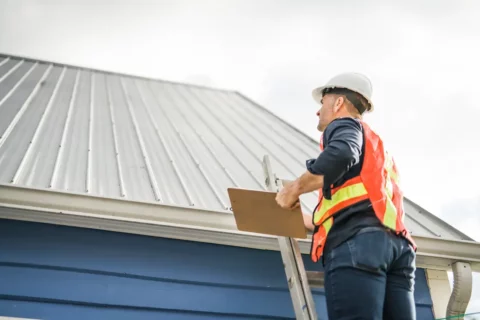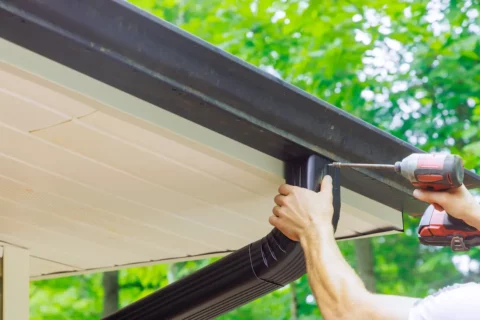
Spring Roofing Checklist for Denver Homes in 2025
Spring Roofing Checklist for Denver Homes: Preparing for Hail and High Winds in 2025
Spring in Colorado brings unpredictable weather and the risk of hailstorms that can wreak havoc on your roof. Did you know that Colorado residents experience 94 hail storms each year? It is no wonder why maintaining a strong, durable roof is critical for homeowners here. Following a simple spring roofing checklist ensures your roof is ready to withstand harsh spring storms.
Spring Roofing Checklist
Here are the expert tips on preparing your roof for the upcoming storm season.
Inspect for Hail Damage
As the days get longer and the snow begins to melt, it is the perfect time to think about inspection, not just inside your home but also on your roof. Denver is known for its springtime hailstorms, which can cause significant damage to your roof. Though often short-lived, these storms can leave behind dents, cracks, and holes in roofing material.
As part of your spring roofing checklist, conduct a thorough inspection for any signs of hail damage. Look for:
- Dents or bruises in shingles
- Cracks or splits in shingles or other roofing materials.
- Scattered debris or granules in your gutters,
- Water stains on your ceiling as it indicates hidden roof damage.
Hail damage can be a tricky spot, and often, the effects are more than just cosmetic. If you are not comfortable inspecting your roof yourself, it is always best to reach out to a trusted Denver roofer to assist with evaluation.
Clear Debris from Gutters
Debris in your gutters can cause water to back up, eventually leading to leaks and water damage. High winds and spring storms can bring in all kinds of debris, from leaves to branches. When gutters are full of leaves and other debris, water can’t flow freely through them. This can cause leaks or even structural damage.
As part of your spring roofing checklist, make sure to clean your gutters thoroughly. Remove leaves, twigs, and any other debris that has accumulated. If you are uncomfortable doing this yourself, many Denver roofing companies offer gutter cleaning as part of their maintenance service. Don’t forget to check the downspouts to ensure they are clear as well.
Check for Proper Ventilation
Without sufficient ventilation, your attic can become a hotbed for moisture, leading to mold growth, wood rot, and even structural damage. This is particularly important in spring when temperature fluctuations can cause condensation to build up. Check for
- Adequate intake and exhaust vents. Intake vents allow cool air to flow in your attic, while exhaust vents enable hot air and moisture to escape.
- Signs of moisture buildup or condensation
- Insulation that is dry and in good condition.
If you find ventilation issues, it may be time for an upgrade. It is better to consult with a Denver roofer to assess the situation and recommend the best solution.
Examine the Flashing Around Vents and Chimneys
Flashing is utilized to seal joints and prevent water from leaking into your home. Over time, flashing around your vents, skylights, and chimneys can wear down, crack, or become loose. This can allow water to seep in, which could lead to leaks and water damage. As part of your spring roofing checklist, inspect all areas where flashing is installed. Inspect for:
- Cracks or gaps in the sealant.
- Rust or corrosion on metal flashing.
- Any signs of mold or mildew around the seams.
Any issues with flashing should be addressed as soon as possible. Preventing water from entering through these vulnerable spots can save you from costly repairs later.
Check for Loose or Missing Shingles
Strong gusts can loosen or even remove shingles, leaving your roof vulnerable to further damage. In your spring roofing checklist, make a spot to inspect your shingles. Look for any that are:
- Curling or lifting at the edges
- Cracked or missing entirely
- Fading or discolored
If you notice any of these issues, it is important to address them quickly. A quick roof repair from a reliable Denver roofing company can help avoid costly roof replacements in the future.
Look for Moss, Algae, and Lichen Growth
Spring is a season of growth, and that includes unwanted growth on your roof. Moss, algae, and lichen can thrive on a roof, especially in high-humidity or rainfall areas. These organisms can damage shingles by lifting them and trapping moisture underneath, which can lead to rot and deterioration.
Remove moss and algae with a cleaning solution. Otherwise, you can contact professional service to do the job safely.
Trim Overhanging Tree Branches
Springtime brings new growth to trees, and while they are beautiful, overhanging branches can threaten your roof during storms. High winds or hail can cause branches that are too close to your roof or home.
Trim any branches that are too close to your roof. Additionally, cutting back branches helps improve airflow around your roof, which can prevent moisture buildup.
Evaluate the Need for Roof Replacement
Another important thing on your spring roofing checklist is to assess the overall age and condition of your roof. If your roof is 20 or 30 years old or has significant damage, it might be time to consider a Denver roof replacement. Look for these signs to help determine if it’s time for a replacement.
- Missing or damaged shingles that can’t be replaced
- Significant sagging or pooling water on the roof
Schedule a Professional Roof Inspection
Finally, one of the best ways to ensure your roof is ready for unpredictable spring weather is to schedule a professional roof inspection. A trained Denver roofer can identify issues you might miss during a DIY inspection.
Many Denver roofing companies offer free roof inspection or affordable maintenance packages that can help you stay ahead of problems. It’s a small investment that can prevent major expenses down the road.
FAQs
What are the signs that my roof needs replacement?
Signs of roof replacement include extensive shingle damage, persistent leaks, and noticeable sagging.
How often should I clean my gutters?
Gutters should be cleaned at least twice a year.
Can I perform a roof inspection myself?
You can perform a basic visual inspection by ensuring safety first, but it is best to contact a professional roofer for a thorough evaluation.
Conclusion
With unpredictable weather, now is the perfect time to review your spring roofing checklist and ensure your roof is ready for spring challenges. If you notice any issues or simply want a professional to assess your roof’s condition, don’t hesitate to contact 303 Roofers.
Contact us today for a free roof inspection or a free roofing estimate!



